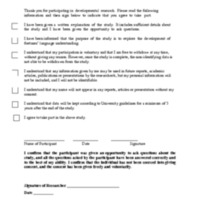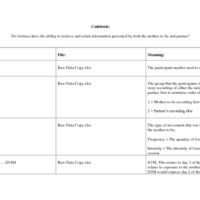Do foetuses have the ability to retrieve and retain information presented by both the mother-to-be and partner?
Dublin Core
Title
Do foetuses have the ability to retrieve and retain information presented by both the mother-to-be and partner?
Creator
Hope Butler
Date
08/09/2021
Description
The complex phenomenon of language development is a vital criterion for communication and for the strengthening of the attachment bond between caregiver and baby (Chew & Ng, 2021). The period in which humans begin to process speech is difficult to define; previous research has identified that foetuses that have the capacity to retain linguistic information presented to them over six weeks by their mother-to-be show a preference for this information postnatally (DeCasper and Spence, 1986). However, the language environment of the foetus also likely incorporates that of the secondary carer role and very little research has investigated the role of the partner in influencing language retention. This study aims to investigate the extent to which foetuses have the ability to retrieve and retain linguistic input presented to them by both their mother-to-be and their partner. A within-measures design with two participant pairs who were recruited via opportunistic sampling through Lancaster University’s Babylab was conducted. Participants were asked to record themselves reading “The Cat in the Hat” and play both of the recordings to the foetus every day for two weeks. During these sessions, the mother-to-be was required to count the frequency of kicks and the movement intensity per session. The findings concluded that foetuses can retrieve and retain language that is presented over a two-week period at only 32 weeks’ gestation. Foetal kicking decreased significantly as exposure to recordings increased. This provides evidence of online processing of linguistics at 32 weeks’ gestation, implying that the full six-week exposure, as previous research indicated, is not necessary thus providing evidence of an innate processing of language. Although there is scope of environmental influence on this. No significant impact of parent recording on foetal ability to process language was found. This suggests that humans have an innate ability to process linguistic information which is despite levels of exposure to voice. However, this conclusion is based on a null hypothesis in an underpowered study; it would be very beneficial for further research to use a larger sample size to increase statistical power and be more representative of the general public.
Subject
language, foetus, mother-to-be, partner, retention
Source
Methods:
Ethics Statement:
Ethical approval was granted by Lancaster University Psychology Department on the 12th of April 2021 before any data collection was completed. Participants were provided with information for review and asked to complete an informed consent form online before participating within this experiment and were given the option to withdraw at any point of the study.
Participants:
Three mothers-to-be and their partners were recruited via opportunistic sampling through Lancaster University BabyLab social media (http://wp.lancs.ac.uk/babylab/) and word of mouth in exchange for a £5 book voucher from Waterstones. In order to take part in this research mothers-to-be must live with a partner and also have a foetal gestation age of between 32-34 weeks. If any participants were bilingual, they were asked to record the story in English to ensure reliability.
Materials and Measures:
Due to current restrictions because of COVID-19, this experiment took place online. Participants were sent an email containing a link to a Qualtrics survey. Qualtrics is a software that allows participants to access surveys and questionnaires on all digital devices at any point of time to help aid easy distribution.
Qualtrics Survey:
To complete this survey, participants were required to have access to a mobile device or computer. The Survey contained the information sheet, consent form, instructions, and demographic questions. The questionnaire consisted of questions asking the mother-to-be to rate the intensity of movements and state the frequency of kicking per session (see Appendix A). The intensity of kicks were recorded using a scale bar where mothers-to-be could rate the intensity of the kicking per session (0-100).
Recording “The Cat in the Hat”:
Participants were given a copy of an extract from “The Cat in the Hat” and both the mother- to-be and their Partner were asked to record themselves reading the story aloud using a device that they were then able to play the recording on every day for two weeks. This was estimated to take between five and ten minutes depending on reading speed per participant.
To control the decibel of their recordings, parents were advised to download the “Decibel X” app which can monitor sound level in order to keep it at the recommended 90db (Luu, T, 2011). Also, to help mothers track their foetal kicks, they were also advised to download the NHS “kicks count” app which helped mothers-to-be accurately count the frequency of kicks per story session.
At the end of the survey and after completion of the study, participants were given a debrief sheet which contained the aims of the research study and any contact information they might need for further questions.
Design:
This research study used a within-measures design as all participants took part in all sections of the experiment. The independent variables in the study were the parent reading the story which has two levels; the mother-to-be or their partner. The second independent variable related to the time point from day one until the end of the two weeks. The dependent variables were the frequency and intensity of foetal kicking during the exposure to both the mother-to- be and their partners recording of “The Cat in the Hat”. This was measured by the mother-to- be.
Procedure:
Once they had consented, the mother to be and partner were given an extract from the story “The Cat in the Hat” via the Qualtrics survey and were asked to record themselves individually reading the story on a device that they were able to play back on several occasions. Once the story had been recorded by both the mother-to-be and their partner, they were asked to play the story to the foetus every day for two weeks. The order of presentation was counterbalanced.
While the study was being recorded, the mother was required to monitor the intensity and frequency of kicks that occurred for the duration of the auditory exposure. The mother-to- be was told to do this for both the duration of exposure to the recordings every day and then upload the outcomes for each session using the original Qualtrics survey link.
Analysis:
Rstudio is a professional software that allows for programming statistical analysis, production of graphs and tables that were used to analyse that data collected. Linear mixed effects model was conducted for analysis.
Ethics Statement:
Ethical approval was granted by Lancaster University Psychology Department on the 12th of April 2021 before any data collection was completed. Participants were provided with information for review and asked to complete an informed consent form online before participating within this experiment and were given the option to withdraw at any point of the study.
Participants:
Three mothers-to-be and their partners were recruited via opportunistic sampling through Lancaster University BabyLab social media (http://wp.lancs.ac.uk/babylab/) and word of mouth in exchange for a £5 book voucher from Waterstones. In order to take part in this research mothers-to-be must live with a partner and also have a foetal gestation age of between 32-34 weeks. If any participants were bilingual, they were asked to record the story in English to ensure reliability.
Materials and Measures:
Due to current restrictions because of COVID-19, this experiment took place online. Participants were sent an email containing a link to a Qualtrics survey. Qualtrics is a software that allows participants to access surveys and questionnaires on all digital devices at any point of time to help aid easy distribution.
Qualtrics Survey:
To complete this survey, participants were required to have access to a mobile device or computer. The Survey contained the information sheet, consent form, instructions, and demographic questions. The questionnaire consisted of questions asking the mother-to-be to rate the intensity of movements and state the frequency of kicking per session (see Appendix A). The intensity of kicks were recorded using a scale bar where mothers-to-be could rate the intensity of the kicking per session (0-100).
Recording “The Cat in the Hat”:
Participants were given a copy of an extract from “The Cat in the Hat” and both the mother- to-be and their Partner were asked to record themselves reading the story aloud using a device that they were then able to play the recording on every day for two weeks. This was estimated to take between five and ten minutes depending on reading speed per participant.
To control the decibel of their recordings, parents were advised to download the “Decibel X” app which can monitor sound level in order to keep it at the recommended 90db (Luu, T, 2011). Also, to help mothers track their foetal kicks, they were also advised to download the NHS “kicks count” app which helped mothers-to-be accurately count the frequency of kicks per story session.
At the end of the survey and after completion of the study, participants were given a debrief sheet which contained the aims of the research study and any contact information they might need for further questions.
Design:
This research study used a within-measures design as all participants took part in all sections of the experiment. The independent variables in the study were the parent reading the story which has two levels; the mother-to-be or their partner. The second independent variable related to the time point from day one until the end of the two weeks. The dependent variables were the frequency and intensity of foetal kicking during the exposure to both the mother-to- be and their partners recording of “The Cat in the Hat”. This was measured by the mother-to- be.
Procedure:
Once they had consented, the mother to be and partner were given an extract from the story “The Cat in the Hat” via the Qualtrics survey and were asked to record themselves individually reading the story on a device that they were able to play back on several occasions. Once the story had been recorded by both the mother-to-be and their partner, they were asked to play the story to the foetus every day for two weeks. The order of presentation was counterbalanced.
While the study was being recorded, the mother was required to monitor the intensity and frequency of kicks that occurred for the duration of the auditory exposure. The mother-to- be was told to do this for both the duration of exposure to the recordings every day and then upload the outcomes for each session using the original Qualtrics survey link.
Analysis:
Rstudio is a professional software that allows for programming statistical analysis, production of graphs and tables that were used to analyse that data collected. Linear mixed effects model was conducted for analysis.
Publisher
Lancaster University
Format
data/r.csv
Identifier
Butler2021
Contributor
Rebecca James and Livvi Taylor
Rights
Open
Relation
No Relation
Language
English
Type
Data
Coverage
LA1 4YF
Files
Collection
Citation
Hope Butler , “Do foetuses have the ability to retrieve and retain information presented by both the mother-to-be and partner?,” LUSTRE, accessed December 15, 2025, https://www.johnntowse.com/LUSTRE/items/show/103.


